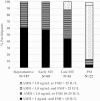Beyond Premature Ovarian Insufficiency: Staging Reproductive Aging in Adolescent and Young Adult Cancer Survivors
- PMID: 33141175
- PMCID: PMC7823232
- DOI: 10.1210/clinem/dgaa797
Beyond Premature Ovarian Insufficiency: Staging Reproductive Aging in Adolescent and Young Adult Cancer Survivors
Abstract
Context: Although stages of reproductive aging for women in the general population are well described by STRAW+10 criteria, this is largely unknown for female adolescent and young adult cancer survivors (AYA survivors).
Objective: This work aimed to evaluate applying STRAW + 10 criteria in AYA survivors using bleeding patterns with and without endocrine biomarkers, and to assess how cancer treatment gonadotoxicity is related to reproductive aging stage.
Design: The sample (n = 338) included AYA survivors from the Reproductive Window Study cohort. Menstrual bleeding data and dried-blood spots for antimüllerian hormone (AMH) and follicle-stimulating hormone (FSH) measurements (Ansh DBS enzyme-linked immunosorbent assays) were used for reproductive aging stage assessment. Cancer treatment data were abstracted from medical records.
Results: Among participants, mean age 34.0 ± 4.5 years and at a mean of 6.9 ± 4.6 years since cancer treatment, the most common cancers were lymphomas (31%), breast (23%), and thyroid (17%). Twenty-nine percent were unclassifiable by STRAW + 10 criteria, occurring more frequently in the first 2 years from treatment. Most unclassifiable survivors exhibited bleeding patterns consistent with the menopausal transition, but had reproductive phase AMH and/or FSH levels. For classifiable survivors (48% peak reproductive, 30% late reproductive, 12% early transition, 3% late transition, and 7% postmenopause), endocrine biomarkers distinguished among peak, early, and late stages within the reproductive and transition phases. Gonadotoxic treatments were associated with more advanced stages.
Conclusions: We demonstrate a novel association between gonadotoxic treatments and advanced stages of reproductive aging. Without endocrine biomarkers, bleeding pattern alone can misclassify AYA survivors into more or less advanced stages. Moreover, a large proportion of AYA survivors exhibited combinations of endocrine biomarkers and bleeding patterns that do not fit the STRAW + 10 criteria, suggesting the need for modified staging for this population.
Keywords: STRAW; adolescent and young adult cancer; menopausal transition; premature ovarian insufficiency; reproductive aging.
© The Author(s) 2020. Published by Oxford University Press on behalf of the Endocrine Society. All rights reserved. For permissions, please e-mail: journals.permissions@oup.com.
Figures

Similar articles
-
Modeling Variation in the Reproductive Lifespan of Female Adolescent and Young Adult Cancer Survivors Using AMH.J Clin Endocrinol Metab. 2020 Aug 1;105(8):2740-51. doi: 10.1210/clinem/dgaa172. J Clin Endocrinol Metab. 2020. PMID: 32270202 Free PMC article.
-
Endocrine features of menstrual cycles in middle and late reproductive age and the menopausal transition classified according to the Staging of Reproductive Aging Workshop (STRAW) staging system.J Clin Endocrinol Metab. 2007 Aug;92(8):3060-7. doi: 10.1210/jc.2007-0066. Epub 2007 Jun 5. J Clin Endocrinol Metab. 2007. PMID: 17550960
-
Antimullerian hormone and inhibin B are hormone measures of ovarian function in late reproductive-aged breast cancer survivors.Cancer. 2010 Feb 1;116(3):592-9. doi: 10.1002/cncr.24746. Cancer. 2010. PMID: 19918920 Free PMC article.
-
Executive summary of the Stages of Reproductive Aging Workshop +10: addressing the unfinished agenda of staging reproductive aging.Climacteric. 2012 Apr;15(2):105-14. doi: 10.3109/13697137.2011.650656. Epub 2012 Feb 16. Climacteric. 2012. PMID: 22338612 Free PMC article.
-
Reproductive ability in survivors of childhood, adolescent, and young adult Hodgkin lymphoma: a review.Hum Reprod Update. 2023 Jul 5;29(4):486-517. doi: 10.1093/humupd/dmad002. Hum Reprod Update. 2023. PMID: 36779325 Free PMC article. Review.
Cited by
-
Perceived and Objective Fertility Risk Among Female Survivors of Adolescent and Young Adult Cancer.JAMA Netw Open. 2023 Oct 2;6(10):e2337245. doi: 10.1001/jamanetworkopen.2023.37245. JAMA Netw Open. 2023. PMID: 37819662 Free PMC article.
-
Serum Anti-Müllerian Hormone Levels and Risk of Premature Ovarian Insufficiency in Female Childhood Cancer Survivors: Systematic Review and Network Meta-Analysis.Cancers (Basel). 2021 Dec 16;13(24):6331. doi: 10.3390/cancers13246331. Cancers (Basel). 2021. PMID: 34944951 Free PMC article. Review.
-
Diminished ovarian reserve in adolescent cancer survivors treated with heavy metal chemotherapy.Pediatr Blood Cancer. 2023 Aug;70(8):e30448. doi: 10.1002/pbc.30448. Epub 2023 May 27. Pediatr Blood Cancer. 2023. PMID: 37243931 Free PMC article.
-
Evaluation of ovarian functions in girls treated for hematological malignancy.Sci Rep. 2025 Mar 4;15(1):7542. doi: 10.1038/s41598-025-92411-z. Sci Rep. 2025. PMID: 40038512 Free PMC article.
-
Long-term antimüllerian hormone patterns differ by cancer treatment exposures in young breast cancer survivors.Fertil Steril. 2022 May;117(5):1047-1056. doi: 10.1016/j.fertnstert.2022.01.016. Epub 2022 Feb 23. Fertil Steril. 2022. PMID: 35216831 Free PMC article.
References
-
- American Cancer Society. Cancer Treatment & Survivorship Facts & Figures 2016-2017. Atlanta: American Cancer Society; 2016.
-
- Overbeek A, van den Berg MH, van Leeuwen FE, Kaspers GJ, Lambalk CB, van Dulmen-den Broeder E. Chemotherapy-related late adverse effects on ovarian function in female survivors of childhood and young adult cancer: a systematic review. Cancer Treat Rev. 2017;53:10-24. - PubMed
-
- Wallace WH, Thomson AB, Saran F, Kelsey TW. Predicting age of ovarian failure after radiation to a field that includes the ovaries. Int J Radiat Oncol Biol Phys. 2005;62(3):738-744. - PubMed
-
- Carter J, Rowland K, Chi D, et al. . Gynecologic cancer treatment and the impact of cancer-related infertility. Gynecol Oncol. 2005;97(1):90-95. - PubMed
Publication types
MeSH terms
Substances
Grants and funding
LinkOut - more resources
Full Text Sources
Medical

